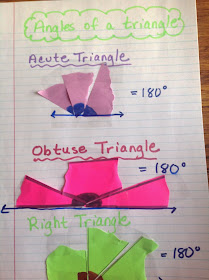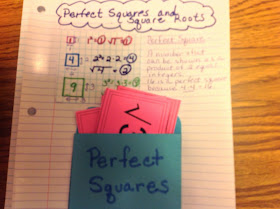Pythagorean Theorem Investigation
I will introduce Pythagorean Theorem with the Starburst candy activity. I was inspired by Pam Lucken's video to use Starburst candies as a manipulative to form the sides of the triangles. I have seen the same project using other manipulatives as well. I just think candy will be fun. My goal is for the students to be able to discover the Pythagorean Theorem on their own. When they have finished the activity it will go in their interactive notebooks.
Students will need:
- A copy of the Starburst Triangle Investigation and direction sheet.
- A plastic bag with 340 Starbursts in each bag. (Maybe 350 to account for accidental eating.)
- A plastic bag with triangle measurement sides for the six triangles they will model.
- Paper, pencil and straightedge.
Click here for: Starburst triangle investigation and
Triangle Exploration Worksheet ( adapted from Alexander Sabitino, Picking Pythagorus.)
Directions for Starburst Exploration, Starburst triangles to measure pg 1,
starburst triangles to measure pg 2
Triangle Exploration Worksheet ( adapted from Alexander Sabitino, Picking Pythagorus.)
Directions for Starburst Exploration, Starburst triangles to measure pg 1,
starburst triangles to measure pg 2
My students will follow the directions on the Triangle Exploration worksheet and create triangles with the side lengths given on the cards in their envelopes. They will determine if the sides form a triangle, classify what type of angle is formed by the largest angle and if the area of the smaller sides cover the largest side.
Pythagorean Theorem Foldable
The next day we will make this foldable and place it into our INB'directions for Starburst activitys.
Click here for Pythagorean Theorem foldable template.
Interesting Lessons
Time for some interesting problems from Mrs. Hester's Classroom and Embrace the Drawing Board. Check their entire lessons on the link provided. I love these two lessons.
Lessons from Mrs. Hester's Pythagorean Theorem Lesson.
And here are some more wonderful INB pages from Mrs. Hester's Classroom.
Lesson Will the TV fit, from Tim's 3 act from Embrace the Drawing Board.
Pythagorean Triples
In the past, Pythagorean Triples have been one or two problems where the topic has been mentioned and not much more. I plan on spending a few day on triples this year.
OK, I don't have this foldable completely finished but thought I would give you a preview. Final foldable will be posted soon. Promise!
And here are some videos.
I love Robert Kaplinsky - Wizard of Oz, Pythagorean Theorem problem. See if you can find all the errors in the video before looking at his answers. I can't believe that so many of my students have never seen this movie. I may be dating myself but we watched it every Thanksgiving when we had only 4 channels to watch on TV. My how times have changed.
Some teachers would probably use this at the beginning of the unit, but I want my students to have lots of practice with Pythagorean Theorem before they see this video. I am going to use it at the end of the unit. They will have practiced many times and be able to verbalize or write down the errors they see.
And of course, Dan Meyer's 3 act, taco cart lesson. Check his site to see all 3 acts with questions and more. It is outstanding and the kids love guessing to see who will get to the taco cart first.
Distance Between Two Points
I'm excited to use Mary's lesson distance between 2 points at Curiouser and Curiouser. Read Mary's post to see the rest of the lesson. I'm hoping that the hallway outside my classroom is large enough for this. If not I will go to the main hall of the building. I like how the students will need to decide how to measure the sides. I've already started to think about how to group the students for this activity so they will be successful. Thanks Mary for posting this lesson.
I know that I will add to my plans throughout the unit. My lesson plans change depending on the students needs. Look for photos of students in my next post.
Til next time,
Jan





.JPG)


.JPG)
.JPG)
.JPG)



.JPG)








